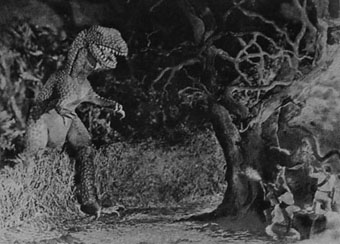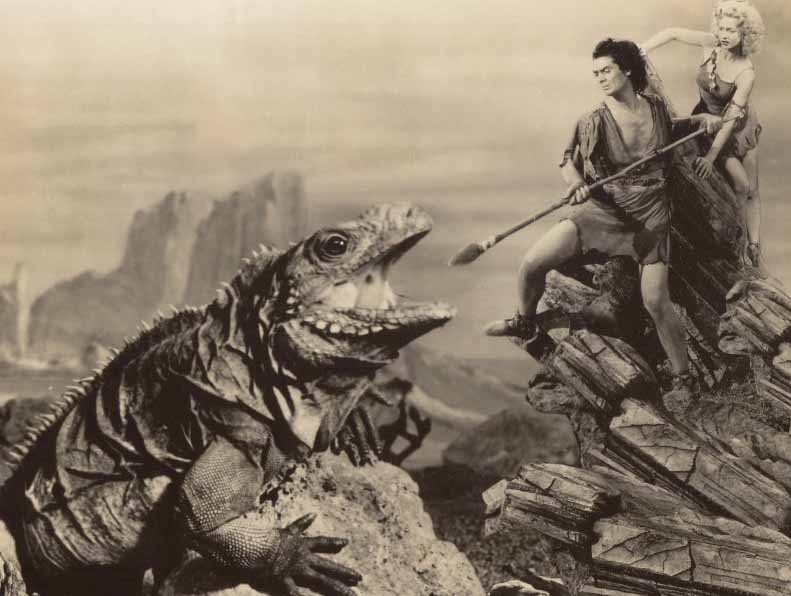
1960 was not necessarily the Year of the Dinosaur, but it did feature a pair of science fiction films that clearly delineate two different approaches Hollywood used during this era to portray the ravenous reptiles on screen: DINOSAURUS and THE LOST WORLD. Neither film is a milestone in its presentation of carnivorous carnosaurs, but each has its own goofy charm for those with an appreciation for the sort of old-fashioned special effects used in the days before computer-generated imagery – in this case, stop-motion puppets and live-action lizards.

By 1960, both techniques had been well established. The use of stop-motion to depict prehistoric beasts on screen dated back to the silent era, when Willis O’Brien pioneered the technique on short subjects like GERTIE THE DINOSAUR (1915) and the feature-length THE LOST WORLD (1925), the first adaptation of Sir Arthur Conan Doyle’s novel, about a expedition to a plateau where evolution has hit a stand-still, allowing the supposedly extinct animals to continue living into the 20th Century. O’Brien went on to perfect the technique in KING KONG and SON OF KONG (both 1933). However, because of the time and expense (stop-motion involves shooting miniature armatures one frame at a time, adjusting the armature between frames to create the illusion of movement), stop-motion was never widely adopted, and only a relative handful of films utilized it to depict dinosaurs: THE LOST CONTINENT (1951), THE ANIMAL WORLD (1956), and THE BEAST OF HOLLOW MOUNTAIN (1956).

The first known use of modern reptiles to replicate dinosaurs on screen had occurred in ONE MILLION B.C. (1940),* which saved time and money by simply gluing fins and horns onto monitor lizards, baby alligators, and iguanas. Of course, the results resembled dinosaurs only in terms of being reptiles with scales, teeth, and claws. As if this were not bad enough, the treatment of the animals is clearly inhumane (a death by avalanche is depicted by dropping a load of rocks onto an iguana; the big dino-fight set piece features the monitor lizard and the alligator biting and clawing each other – for real). According to Denis Gifford in A Pictorial History of Horror Movies, this all-too-real carnage raised the ire of the American Society for the Prevention of Cruelty to Animals, leading to a ban on similar scenes. Consequently, later low-budget dinosaur films either used men in dino-suits (e.g., 1957’s THE LAND UNKNOWN) or recycled ONE MILLION B.C.’s footage: PREHISTORIC WOMEN (1950), TWO LOST WORLDS (1950), UNTAMED WOMEN (1952), ROBOT MONSTER (1953), and TEENAGE CAVEMAN (1958). Nevertheless, at least a few subsequent films shot new footage of made-up lizards as dinosaurs: UNKNOWN ISLAND (1948), KING DINOSAUR (1955), and JOURNEY TO THE CENTER OF THE EARTH (1959).

This, then, is the historical backdrop against which DINOSAURUS and THE LOST WORLD painted their pictures of prehistoric life surviving into the modern world. The former picture is an attempt by the team behind THE BLOB (1957) – producer Jack H. Harris and director Irvin S. Yeaworth – to upscale with a bigger-budget production, shot in widescreen and released by a major distributor (Universal Pictures). The story involves a Brontosaurus and a Tyrannosaurus Rex accidentally brought to life on an isolated island resort. Hired to provide the special effects was the team of Tim Baar, Wah Chang, and Gene Warren, with uncredited help from model builder Marcel Delgado (who had worked on KING KONG) and several stop-motion animators.
The advantage of stop-motion over costumed lizards or men in suits is that the miniature model can be far more anatomically correct in terms of proportions and resemblance to actual dinosaurs. The advantage of stop-motion over mechanical models is that the frame-by-frame shooting process allows careful positioning of the puppets, which helps imbue the creatures with life-like movements. The disadvantage is that miniature models can be hard to detail correctly; also the fact that the models are not actually moving when each frame is exposed creates a perfectly clear image, lacking motion blur, which results in a staccato, stroboscopic look, especially when the creatures are supposed to move quickly.

Unfortunately, the dinosaurs in DINOSAURS fall victim to these disadvantages. The creatures are convincingly terrifying to youngsters, but older viewers will most likely find them quaint in their execution. Nevertheless, fans of the stop-motion process will find them interesting, and some of the action is imaginative, such as the final-reel confrontation between the T-Rex and a steam shovel.
The 1960 version of THE LOST WORLD is an attempt by producer Irwin Allen (LOST IN SPACE) to remake the 1925 silent classic with sound and color, featuring an all-star cast: Michael Rennie from DAY THE EARTH STOOD STILL (1951), David Hedison from THE FLY (1958), and Claude Rains from THE INVISIBLE MAN (1933), along with Jill St. John along for sex appeal. Although Willis O’Brien, from the original film version of THE LOST WORLD, is credited as an effects technician, stop-motion was eschewed for cost reasons, with L.B. Abbott, James B. Gordon, and Emil Kosa Jr. optically enlarging monitor lizards made up to resemble (allegedly) their prehistoric ancestors.

The advantage of real lizards is that they are clearly alive, and they move very convincingly: their tongues flick; their claws grasp, and their bodies flop about, without the artificially precise stylization inherent in stop-motion. The disadvantage is that they are obviously not dinosaurs. The addition of fins and horns does little to create a resemblance to Stegosaurus or Triceratops, and Professor Challenger, the film’s alleged expert in paleontology, comes across as a bit of a fool as he identifies each new hybrid monstrosities by name, suggesting for example that one belly-crawling beast is a Brontosaurs, a creature structured more like a suspension bridge.

The other big problem with the live-action approach to special effects is that, once again, we are presented with a real-life tussle between two wild animals. Fans of cockfighting may not have much problem with this, but more enlightened viewers are likely to shake their heads in wonder that only five decades ago, Hollywood filmmakers still thought that watching animals harm each other on screen was an innocent evening’s entertainment. (To be fair, one should note that even today, the prospect of witnessing animal atrocities draw eyeballs to YouTube videos of animals devouring each other. But at least in cases like these, the action has not been staged for the camera.)

Modern viewers, accustomed to the glossy digital dinosaurs in films like JURASSIC PARK (1993) and JOURNEY TO THE CENTER OF THE EARTH (2008) will likely be disappointed by the old-fashioned effects in DINOSAURS and THE LOST WORLD. Even fans with a nostalgic fondness for classic films will prefer the superior work seen in the previous version THE LOST WORLD and in the subsequent remake of ONE MILLION YEARS B.C. (featuring Ray Harryhausen’s dynamated dinosaurs, upstaged by Raquel Welch in a fur bikini). Nevertheless, the 1960 versions of DINOSAURUS and THE LOST WORLD provide a marvelous snap-shot of Hollywood’s efforts to recreate extinct life forms in the era before special effects became the province of computer operators.
FOOTNOTE:
- As Mark Leeper points out in comments below, THE SECRET OF THE LOCH (1934) used a live iguana to portray the Loch Ness Monster. Whether Nessie is a dinosaur is at least open to debate, but the film definitely deserves credit for using live-action lizard technique before ONE MILLION B.C. Although the film itself is rather slow and dated, the composite effects used to place the monster in the same scene with the actor (during a dive beneath the loch’s surface) are very effective. Unfortunately, the effect is somewhat diminished by the fact that, instead of swimming, the monster crawls on the loch’s bed – without, rather miraculously, raising any swirling silt to muddy the water.
Below, check out more images from DINOSAURS and THE LOST WORLD.






Let’s not forget that FIRST SPACESHIP TO VENUS also featured some dinosaurs as well.
But those are Venusian dinosaurs! So they don’t count! 🙂
UPDATE: Actually, Dennis, you must be thinking of some other Easter Bloc sci-fi film, as there are no dinosaurs in FIRST SPACESHIP TO VENUS. One of the film’s big dramatic moments comes at the very end, when a dying botanist learns that his experiments with seeds have proven there is life on Venus – which would not need proving if there were giant reptiles roaming the land.
“The first known use of modern reptiles to replicate dinosaurs on screen had occurred in ONE MILLION B.C. (1940).”
That is debatable. THE SECRET OF THE LOCH (1934) is usually considered a dinosaur movie. Mark Berry includes it in his book DINOSAUR FILMOGRAPHY. The creature at the bottom of the loch is played by a live iguana.
This may be splitting hairs but I don’t consider the Loch Ness monster a dinosaur. Some people who believe in Nessie think the creature may be a surviving plesiosaur, but technically speaking that is not the same thing as a dinosaur.
Still, THE SECRET OF LOCH NESS probably deserves credit for establishing the precedent of using live reptiles for special effects (there are one or two lost silent films that may have used the technique, but no one seems to know for sure).